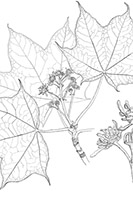![]()
The Red Coliseum Maple is a species of maple tree that is native to Asia, with its natural range extending from central Turkey eastward through the Caucasus region and the Himalayas, reaching as far as southwestern China. The tree belongs to the genus Acer, a name derived from the Latin word for maple. Its species name, cappadocicum, is a direct reference to Cappadocia, a historical region in central Turkey, which is believed to be one of the places where this species originally grew. This connection to its place of origin highlights its deep-rooted history in the landscapes of Asia, where it has thrived for centuries in various climates and elevations. The Red Coliseum Maple stands as a testament to the diversity and adaptability of the Acer genus, with its distinctive characteristics making it a notable presence in the regions it inhabits.
![]()
The Red Coliseum Maple is primarily harvested from the wild, where its wood is utilized for various local purposes. Its strong and durable timber makes it a valuable resource in certain regions where it grows naturally. Beyond its practical uses, this maple species has also been recognized for its potential in environmental conservation efforts. In Turkey, particularly in dry valleys, it has been suggested as a beneficial species for soil stabilization projects, helping to prevent erosion and maintain ecological balance. Additionally, the Red Coliseum Maple is appreciated for its ornamental qualities, making it a popular choice in gardens and landscapes. Its striking foliage and graceful growth habit add aesthetic appeal to parks and private gardens, where it serves as both a functional and decorative element. Whether valued for its wood, its role in ecological restoration, or its beauty, this maple species continues to be an important part of both natural and cultivated environments.
![]() Within the realm of rational and holistic medicine, there is no documented use for red coliseum maple.
Within the realm of rational and holistic medicine, there is no documented use for red coliseum maple.
Please note that MIROFOSS does not suggest in any way that plants should be used in place of proper medical and psychological care. This information is provided here as a reference only.
![]()
There is currently no information on the edibility of the bark, seeds, needles, roots, or sap from the red coliseum maple tree.
Please note that MIROFOSS can not take any responsibility for any adverse effects from the consumption of plant species which are found in the wild. This information is provided here as a reference only.
![]()
The Red Coliseum Maple thrives in a variety of soil types, including light sandy soils and medium loamy soils, making it adaptable to different growing conditions. However, it flourishes best in moist, well-drained soils and benefits from full sun to partial shade exposure. This tree has a particular preference for acidic soils that retain consistent moisture, as dry conditions can be detrimental to its growth and overall health. One distinctive characteristic of the Red Coliseum Maple is its ability to produce root suckers, which can lead to the formation of extensive groves over time if not managed properly. This natural tendency allows the tree to spread and establish itself in favorable environments. Additionally, the Red Coliseum Maple has demonstrated resistance to deer, making it a resilient choice for gardens and landscapes where deer browsing is a concern. Its ability to thrive in specific soil conditions while also exhibiting durability and adaptability further enhances its appeal as both an ornamental and functional tree in various settings.
| Soil Conditions | |
| Soil Moisture | |
| Sunlight | |
| Notes: |
![]()
The Red Coliseum Maple is a medium-sized deciduous tree that typically reaches heights of 20 to 30 meters, forming a broad, rounded crown that provides ample shade. Its distinctive leaves are arranged in opposite pairs and are palmately lobed, featuring five to seven lobes that range in size from 6 to 15 centimeters across. A unique characteristic of this tree is its leaf stems, which release a milky latex when broken. In early spring, the Red Coliseum Maple produces clusters of flowers, known as corymbs, each containing fifteen to thirty small, yellowish-green blooms. Each individual flower consists of five petals, measuring approximately 3 to 4 millimeters in length. Following the flowering period, the tree produces its characteristic seedpods, known as double samaras, which contain two winged seeds. These seeds are distinctly disc-shaped, strongly flattened, and measure between 6 to 11 millimeters in diameter and 2 to 3 millimeters in thickness. The wings of the samaras extend 25 to 30 millimeters in length and are widely spread, approaching a 180-degree angle, which aids in their dispersal by wind.
The bark of the Red Coliseum Maple changes in texture as the tree matures; it starts out smooth and greenish-grey in young trees but gradually develops shallow grooves over time. This species has three recognized varieties, each originating from different regions within its native range. The variety indicum is found in the Himalayas, while sinicum is native to southwestern China. Additionally, the closely related Acer lobelii, which grows in southern Italy, is sometimes classified as a subspecies of the Red Coliseum Maple by certain botanists. Other eastern Asian species, such as Acer amplum, Acer pictum, and Acer truncatum, share many similarities with the Red Coliseum Maple, leading to frequent misidentification in cultivation. Despite these variations and related species, the Red Coliseum Maple remains a distinct and valuable tree known for its ornamental appeal, unique foliage, and adaptability to different environments.
![]()
| Tree Height | 20m to 30m |  |
| Habitat | Well drained acidic soil | |
| Leaves | Palmate | |
| Leaf Margin | Stout Bundles of Three | |
| Leaf Venation | Reticulate | |
| Bark | Shallowly Grooved | |
| Flower Colour | Yellow | |
| Flower Type | Radially Symmetrical | |
| Flowering Season | April to May | |
| Pollination | Wind | |
| Tree Gender | Trees are hermaphrodite trees are self-fertile | |
| Fruit | Small winged seeds | |
| USDA Zone | 5A (-26°C to -28°C) cold weather limit |
![]()
No known health risks have been associated with red coliseum maple. However ingestion of naturally occurring plants without proper identification is not recommended.
![]()
 |
-Click here- or on the thumbnail image to see an artist rendering, from Herzlich Willkommen bei Löwy-Illustration!, of red coliseum maple. (This image will open in a new browser tab) |
![]()
Red Coliseum maple can be referenced in certain current and historical texts under the following other name:

![]()
 |
What's this? What can I do with it? |
![]()
| Mitchell, A. F. (1974). A Field Guide to the Trees of Britain and Northern Europe. Collins ISBN 0-00-212035-6 | |
| Bean, W. J. (1976). Trees and Shrubs Hardy in the British Isles 8th ed., vol. 1. John Murray ISBN 0-7195-1790-7. | |
| Huxley, A., ed. (1992). New RHS Dictionary of Gardening. Macmillan ISBN 0-333-47494-5. | |
| Dickinson, R.; Royer, F.; (2014) Plants of Southern Ontario. ISBN 978-1-55105-906-8. | |
| Rushforth, K. (1999). Trees of Britain and Europe. Collins ISBN 0-00-220013-9. | |
| National Audubon Society. Field Guide To Trees (Eastern Region): Alfred A. Knopf. ISBN 0-394-50760-6 | |
| February 28, 2025 | The last time this page was updated |
| ©2025 MIROFOSS™ Foundation | |
 |
|









